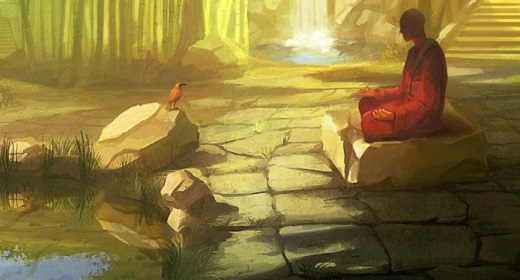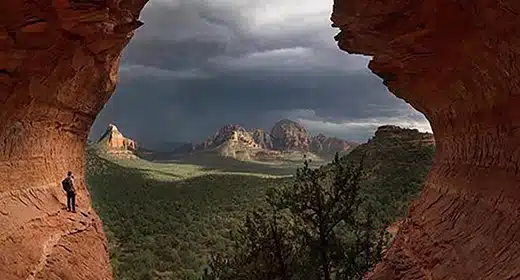Let’s go over ten tricks and tips to help your meditation practice become smoother, expansive and efficient. A meditation practice should be a process of exploration…
All too many westerners limit their practice to a few topics. The majority of people I encounter primarily use it for a moment of rest/clarity or as a healing pause.
Be aware, that mediation can be both simple and offer far more opportunities than you might imagine. Thousands of meditation techniques exist.
- Be curious to try out different versions.
- Be experimental and blend your practices!
Don’t Force Your Practice.
People love to force their meditation practice. Many of the tricks listed on this page are all about making your practice lighter. Meditation is often used as a ladder to become more in life. But becoming more has a trap built into it: the more a person seeks, the more likely they will get sidetracked away from their essence. Meditation should be used to understand and balance your nature.
Don’t force yourself to be something you’re not!
Exploring meditation should be a practice that matches to your lifestyle. As you improve over time, then your practice can likewise evolve and change to be more powerful over time.
If you want to become something beyond your current nature, then work with smaller steps of improvement. Let meditation find those more gentle steps of change, rather than trying to change everything at once.
Focusing your Meditation Focus
People often try to do too much all at once. In doing too much, your meditation practice will wander, lose focus and fizzle.
For example, meditation is often used to manage and reduce pain. Pain will often have components of body, mind, and spirit. Focus your meditation session on tackling one aspect of the pain first rather than all the pain at once. For example: often stories linger behind the pain. Meditate to understand the stories hiding under the pain so you can then release the stories holding you back from healing the pain. Then afterward meditate on the physical pain to work on healing it.
Weeding The Garden
I have a personal technique I call “Weeding the Garden”. The video above will go over the details of this method. Weeding the Garden is a preparatory process used to make your time spent in meditation smoother and more complete in results.
Meditate While Being Well Rested
People often meditate to have a spiritual experience, but their bodies are so worn out that they fall asleep instead.
Simple Rule: If you’re tired: get some sleep rather than meditate.
Follow Up Rule: If you can’t fall asleep, then meditate upon that which is making your restless, and you will fall asleep during your meditation.
Follow Up Follow Up Rule: If you don’t know why you are restless, then meditate upon creating a daydream and focus on the journey. Typically this will put you to sleep. If you are lucky, the daydream will also give you clues on how to heal your restlessness. The clues will often happen at the point in the vision you get stuck, or it keeps repeating. At that point get up, write down the daydream. Also, write down what you felt while being stuck or in a loop. Then do a chore or two, afterward go back to rest and revisit the meditation. Surprisingly either it will flow more smoothly into sleep, or you will get an insight to get you past a problem.
Don’t Forget to Play
It’s a common trap to get stuck into rigid forms and routines in meditation. While working on a precise and refined ancient practice has its merits, training should also always include play.
Let’s be serious; play is serious. Playing is all about going beyond the boundaries of your experience. Playing doesn’t require “form” in fact play is the exploration of possibilities. Predefining play reduces the potential and options for what might happen.
“How do you play in meditation?” the Taoist answer is you just experiment and play with what feels “right.”. If something doesn’t feel right, you stop and look and try something new. Since, meditation is about awareness, as you play, your awareness is expanding and testing whats around you. So in play, over time, you can expand your meditation forms as you figure out what improves your experience and results.
For example, I played in martial arts over 25 years. Martial arts are a form of movement meditation. But it took 20 years of playing: trying different styles before I found the teachings I considered to be my baseline. That doesn’t mean I spent a full 25 years just practicing. It meant every few years I would drop in and try a new style and when that style didn’t feel right, I would drift again to wander. Eventually, I wandered into the forms that worked for me… Along the way, I also discovered so much more with playing in the other styles: that allowed me to expand my general meditation practice in unexpected directions.
If I forced my play to be only one style, one form: I never would have found a style of martial arts which fit my personality and needs.
To play, is to be “free.”
Many people who cannot play cannot do so since they are “not” free. Strangely yes, a person can become trapped by their meditation practice. So don’t forget to play, to expand and improve your awareness practices continually.
Remove Judgment
One problem in meditation is that people often try to imitate how others meditate. We all have seen Hollywood versions of meditation, and the trap is to try and meditate using these bigger than life images.
Don’t measure your meditation practice against other people or media representations. Just because someone can experience visions, float, achieve tranquility upon the 5th circle of black lotus opening (no such practice) doesn’t mean you will have experiences that match to another person. While one person may have a Tibetan tiger experience, you may get the New Jersey Turnpike traffic jam road show or more often the case seemingly nothing at all. Seriously, listening to other people’s meditation experiences is a bit like comparing fishing stories.
Be open minded in your meditation practice to let it be your practice.
Don’t judge other people’s meditation experience as benchmarks for you to attain, use them for insights instead.
In learning meditation it’s useful to compare notes to learn how to meditate better, just don’t try to replicate perfects other people’s experiences. These others experiences are merely suggestions and guidelines to help us polish our practice.
If you are a person who wants a formal structure and precise process, then yes find the meditation practice which defines a strong path for you to explore. If you are an independent and free will person, then meditate without formal structures. No matter what style of approach calls to you, understand in the end your practice is still your own to explore. Don’t limit what you see, will attain or is possible only through other people’s experiences.
Letting Go
We think, and stop right there! That is part of the problem of letting go. We think it’s all about letting the mind relax. Yes, that is part of it, but only one part.
The Body Needs to Release
People shove and repress years of emotions and issues into their bodies. Repression easily interferes with our meditation.
- All the anger one pounds into the feet
- All the stress binding the hamstrings
- All the strain in the wrists
- All that stuff the body has been taught to hold together.
The body has to learn how to let that go.
The Spirit Needs to Relax.
Work and family drama and abuse often suppress a person’s spirit in life. The spirit may need to learn to how to fly again, to be free and not constrained by leases of the mind and body.
Letting go and being aware is a process of mind, body and spirit.
To let go: is to let it all go truly and fully. Once this is done, You discover a new starting point for your meditation sessions.
Releasing into Awareness
One style of meditation is to practice of release, which creates space to increase one’s awareness. When you think a thought, you let it go (with a mantra, a question or a breath). As you do this, release over and over again, it leaves a quiet space within your mind. In this space when a habit or a desire comes up, Let it go, again with a mantra, a question or a breath. To release out of our usual preprogrammed behaviors or habits. Our mind is designed to continually be on the go, to leap from idea to idea. At times we need to go beyond our usual nature: “to release” both into our day to day nature and out of our character both. This style of meditation can be used to break us out of routines we don’t even know we have from our society or family.
As we release these thoughts over and over, an interesting thing happens, you begin to become aware of your senses. Everything becomes more vibrant, and you notice things now everyone else misses. In this variation of meditative practice, you discover “grace” where you can use this expanded awareness to navigate life.
So for example: releasing focus on only one topic. In the release of focus, awareness can then be used to stitch together different aspects of our life together, or hold onto something (such as a single thought) and then apply it to many different parts of our life at once.
Advance Meditation Concepts
Meditate Outside the Mind
We started to go over this in the “Letting Go” section. There is even more to this topic!
Meditation isn’t limited to being performed with the rational mind. Our body and spirit have awareness capacities built into them also. We have our intuitive, heart and stomach minds also in life.
You can focus your meditation practice on these other aspects of life. For example, when I was dealing with some deeply terrible toxic backlash issues from chemical exposures and allergies I would do a body meditation. I would take an hour in the morning soaking in a warm bath to help my liver heal. It was a mindless hour. This was a body meditation, focused purely on soaking in wholeness and allowing the body to recover. I let the body be aware of what it needed to sort itself to be in better health. I didn’t let the mind interfere or try to direct my body, nor did I try to use that time to be in my mind in any manner. It was an hour outside of time for the mind -mindless- but a fully committed hour for the body to be in its meditative state.
Another example: You might feel your stomach mind twisting. Instead of meditating in mind, relax your meditation to float into your stomach mind instead. Let the stomach mind be free to sort out the feelings and urges. Pause outside of rational meditative thoughts to be in the lower mind of the stomach rolling along in its processing. Upon refocusing your practice, it can then give your more normal thoughtful mind based process new angles to process its awareness towards in answers or insights.
Countless other variations exist for nonmind based meditation time exist. Be creative and play by exploring these other options. Dance, yoga, qigong and Tai Chi as are just some of the options you can explore to open up other styles of body and spiritual awareness options you can explore.
Samadhi
Earlier today, I was describing Samadhi to a student, and this was how I expressed it (or my own experience of being in Samadhi):
Samadhi is putting both your mind and essence into neutral, outside of your stories. While your mind is disengaged your essence is flowing as a dandelion seed in the universal winds. Some people call Samadhi the union with the divine. The Sanskrit word can translate as “putting together”, “integration” or “absorption”. In Buddhism, it’s the last step in the Noble Eightfold Path.
Samadhi is a state of mind, well, more a way of holding essence. The term itself comes from India. It isn’t a Taoist concept, but you will find it occasionally in Taoist literature (usually only in western books, not classically). Multiple styles of meditation can get you into various states of Samadhi.
While teaching Samadhi goes beyond the scope of this article, we can still use Samadhi to show how to expand out our meditation practice in a fuller manner. With words, we have a definition – such as Samadhi. But defining Samadhi as I just did is static, and words shift with time. The spirit is never static nor fully captured by a word. So statements we base our meditation practice initial upon is only 1/3rd of the picture.
The 2nd 3rd of teaching is the flow of the experience and how it relates to your evolution.
The 3rd third is the dialogue that follows and how that adds in-depth and angles to the lesson.
We need all three to learn fully.
(1) So look at this statement first by definitions:
Disengage focused self-awareness of consciousness, Let go of your stories and let your awareness explore the universe without direction.
(2) Then meditate into this statement by feeling the flow.
Samadhi is putting both your mind and essence into neutral, outside of your stories. While your mind is disengaged your essence is flowing as a dandelion seed in the universal winds.
(3) Finally, add in depth by following any conversation here or dialogue you find on the internet about Samadhi.
Repeat these three aspects over and over again and then merge the results over time.
Everyone, please don’t be afraid to dive in, that’s part of what makes learning work.
P.S.
No Humpback whales jumped during this segment. While they did jump in my first shooting of this video, I re-shot the video and the 2nd version ended up being whale-less. So goes life.

















































